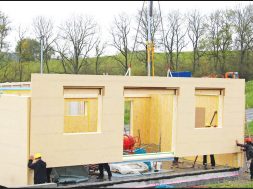Green Mantra – What makes a building energy efficient

Energy efficiency has been the most sought-after word in the present times. Developers all around the globe are adopting sustainable approach to achieve energy efficiency.
Importance of energy efficiency in a building
The existing worldwide mix of energy resources is weighted heavily toward oil, coal, and natural gas. Though estimates regarding the remaining quantity of these resources vary, it is clear that the current dependence on non-renewable energy sources is not sustainable and involves increasingly destructive extraction processes, uncertain supplies, growing market prices, and national security vulnerability. Accounting for approximately 40 per cent of the total energy used at present, buildings are significant contributors to these problems.
Buildings account for an estimated 30 per cent of the total energy consumption in India. As per market report, India needs to augment her primary energy supply by three to four times and electricity generation capacity by six times in order to deliver a sustained economic growth rate of 8 to 9 per cent through 2031-2032. India’s dependence on external supplies of fossil fuels makes it undesirable and unviable to meet this soaring demand by increasing supply. Policy makers have realized that demand side measures such as energy conservation and energy efficiency are vital for India’s energy strategy.
Integrating energy efficiency with sustainable construction
With Indian real estate development swiftly escalating, India could save enough electricity to power 358 million homes per annum by 2030, if states adopt building codes and incentives for developers aimed at boosting energy efficiency in new construction and major retrofits.
Dr Niranjan Hiranandani, Founder and CMD, Hiranandani Group states that, “There are two aspects i.e. it is about conserving natural resources and reducing pollution. Secondly, about ensuring that the end-user gains because of lower costs of electricity, in turn, a result of better planning which ensures more natural lighting within the building (savings on lighting), cross-ventilation as also reduced UV-radiation (reduced use of air conditioning) as also other options which enable making buildings energy efficient. Lesser load on electric power as also fresh water usage within the building helps keep usage of natural resources lower, as also helps in controlling pollution”.
Any building which conserves energy and reduces the load on shared resources like power and water makes a building energy efficient. It includes usage of lighting technology that saves electricity while delivering equal quantum of light; of modern management tools that switch off electric consumption in a room or a corridor where no human is present and so on. “Energy efficient buildings ensure achievement of optimal performance of human resources working within these buildings”, he further adds.
“The opportunity to design a building competently from the start enables more and better efficiency measures to be used. The more new machineries and practices that are adopted in new construction, the more costs will come down and the processes become standard practice”, says Aniket Haware, Managing director, Haware Builders. By incorporating energy efficiency, renewable energy and sustainable green design structures into a building construction at the outset, it can play a significant role – not only regulatory your building’s energy consumption – but also contributing to achieving a sustainable energy structure for our society.
Sustainable Architectural Design
“The reason for a building to be energy efficient is that its industry bears the infamous tag of being one of the biggest consumers (fifty percent) of all energy resources, using it extensively for the purposes of heating/cooling, lighting, servicing, construction processes etc. In an uncontrolled quest for progress (read urbanisation and industrialisation), this consumption is increasing in leaps and bounds while resources are getting depleted at an equally alarming pace”, says Leena Ragade Gupta, Studio Archohm.
Energy efficiency in the building industry is a desperate need of the hour. It is a component of sustainability-seen, not as this ‘overwhelmingly impossible to bear burden’ but as a set of ‘small doable gestures involving a measure of awareness, sense of responsibility and know-how’, that eventually lead up to the bigger impact. This responsibility when realised, results not only in profits that are directly proportional to economic benefits-be it saving money or getting tax benefits, but more importantly, endowing the individual or collective with an innate sense of gratification-an end in itself.
This-‘doing our bit’ infact construes the true accomplishment for us at studio archohm. In recent times, certifications and incentives aimed at recognising and applauding efforts in this domain though awards and accolades have added to the ‘want’ of making buildings energy efficient-this is also alright so long as the objective is attained. We however are not swayed by populism and have been employing basic but impactful measures since our inception more than a decade and a half back. We have recently started talking about these in various forums only from the point of view of demonstrating how these can also be seen as exciting, challenging and satisfying practices apart from their relevance”, she adds further.
For India, as a developing nation, efficiency is perceived in terms of the maximum impact that can be achieved through minimum means, since resources are not in surplus here. Fundamentally and simply put, building is energy efficient if it uses minimal energy for its various purposes and also generates least possible waste which incidentally also consumes energy to be disposed off. We do not shrug it off as not being our responsibility. What happens to something discarded by/from/of our building constitutes a part of our ethical responsibilities, says Leena Ragade Gupta, Studio Archohm.
Ar. Naresh V Narasimhan, Architect-Principal, Venkataramanan Associates, “Traditional structures in India made use of local materials with low embodied energy, natural ventilation systems and cooling strategies. But in recent years, with the predominant influence of the West, contemporary buildings make use of large amounts of glass and steel and are energy-intensive.” Energy efficiency in building technology is not restricted to managing current consumption, but also includes minimizing energy loads right from the construction phase. Technology and innovative materials can play a big role in bringing down the energy consumption of a building.
“There are active and passive strategies that make a building energy efficient. As an architect and planner, the passive ways in terms of designing a building, its orientation and placement, envelope of the building is the key role in conserving energy and optimising use of energy to create an efficient building”, says Ar. Charanjit S Shah, Creative Group. Maximising day light and minimising heat gain is the prime concern in designing such that during the day, natural daylight is used by way of glares free north light and shaded south light. Keeping the heat load in check in terms of air conditioning can be done in case the envelope of the building is layered or insulated to avoid penetration of heat through wall openings, ceiling or glazing. Passive ways by itself can create a reduction in energy use by more than 50-60 per cent, he asserts.
Active ways of use of intelligent building management systems and the efficient use of soft cool LED lights, fixtures, human sensors, automation controls, solar panels, etc. are some of the energy efficiency tools which can further reduce consumption of energy in any of the buildings. Adopting a holistic approach towards green architecture and use of non-commercial system of energy production by way of solar street lights, panels, solar or battery operated vehicles and other equipments and tools besides wind as an alternate source of energy are helpful in creating energy efficient buildings, he adds further.
Bringing technological energy-efficiency
J M Bhambure, Executive Vice President – R&D and Technology, Blue Star Limited says “By 2030, 50-55 per cent of the population is expected to migrate to the cities. With the constraints of availability of land, there will be an increase in high rise buildings.” These high rise buildings have higher requirement of energy, to manage the water distribution and to run the elevators apart from cooling. It is estimated that 70 per cent of the commercial buildings are yet to be built as well as a large part of the population is expected to move to decent residential apartments. Be it commercial buildings or residential apartments, there will definitely be a demand for cooling. Cooling contributes to around 50-60 per cent of the energy consumption.
A large part of energy is consumed by cooling equipment. It is therefore essential to reduce the energy consumption. The cooling requirement basically arises out of ingress of heat due to direct radiation from the sun or conduction through walls and windows. Reduction in the ingress of heat, popularly known as heat load, directly reduces the energy consumption. Architects play a predominant role in terms of design and selection of the construction material. Orientation of the building, shading, ratio of windows to opaque walls, and use of insulating material for the construction of walls and roof, are the main factors to reduce the heat load. It is important to have a building design, built for different climatic conditions of India, he adds.
“Energy being one of the most important aspects, it becomes critical to ensure energy efficiency in a building to avoid future crisis”, says M. Selvarasu, Director, Lead Consultancy and Engineering Services. A building which has been designed and operated for reduced energy demand with passive design and efficient building materials, incorporates technologies such as lighting controls, efficient HVAC systems to consume less energy, uses renewable energy sources can make a building energy efficient, he adds.
Any building which conserves energy and reduces the load on shared resources like power and water makes a building energy efficient.
Dr Niranjan Hiranandani, Founder & CMD, Hiranandani Group
The more new machineries and practices that are adopted in new construction, the more costs will come down.
Aniket Haware, Managing director, Haware Builders
Technology and innovative materials can play a big role in bringing down the energy consumption of a building.
Ar. Naresh V Narasimhan, Architect-Principal, Venkataramanan Associates
For India, as a developing nation, efficiency is perceived in terms of the maximum impact that can be achieved through minimum means.
Leena Ragade Gupta, Studio Archohm
Be it commercial buildings or residential apartments, there will definitely be a demand for cooling.
J M Bhambure, Executive Vice President – R&D and Technology, Blue Star Limited
Energy being one of the most important aspects, it becomes critical to ensure energy efficiency in a building to avoid future crisis.
Selvarasu, Director, Lead Consultancy and Engineering Services
29
Cookie Consent
We use cookies to personalize your experience. By continuing to visit this website you agree to our Terms & Conditions, Privacy Policy and Cookie Policy.









